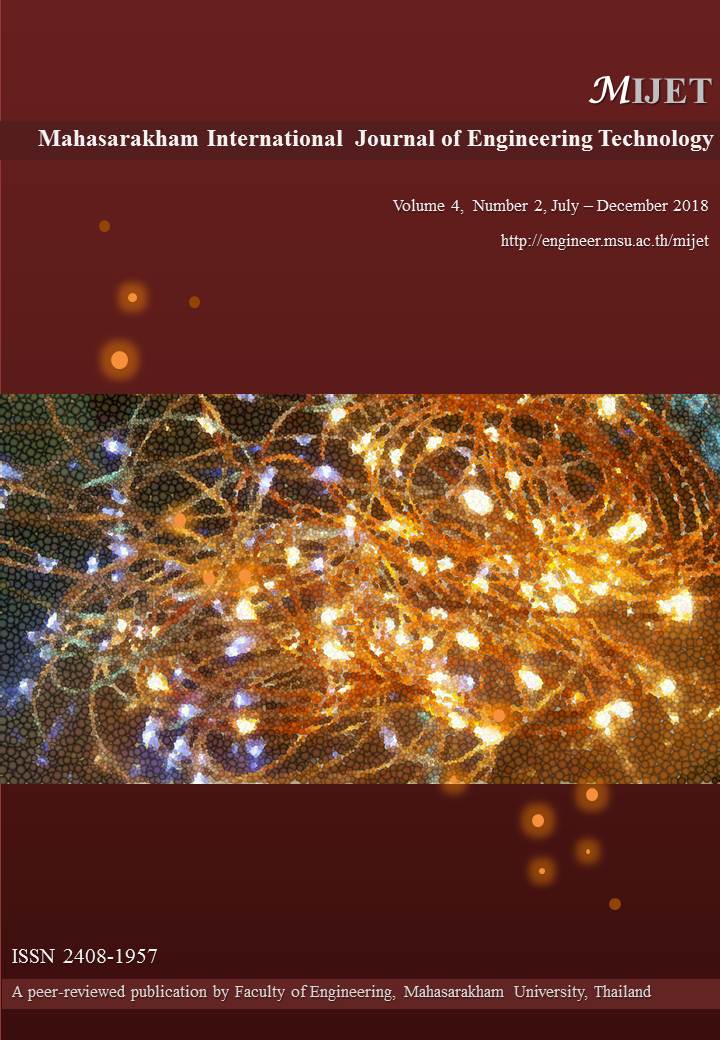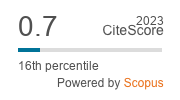Optimizing of Concrete Duct Bank Power Cable using Self-Adapting Control Parameters in Differential Evolution
doi: 10.14456/mijet.2018.8
Keywords:
Underground power cables, concrete duct bank, cable ampacity, the temperature distribution, optimizationAbstract
Underground cable performance with the qualitative aspects of the maximum cable temperature and ampacity are functions of installation conditions. Thus, this work presents an efficient methodology to improve the thermal performance of power cable with respect to optimize structural sizing involving the variables design of concrete duct bank dimensions. The methodology integrates the powerful features of the finite elements method (FEM) technique coupled with the self-adapting control parameters differential evolution algorithm (jDE) for handle various geometrical parameters in the complex surrounding installation case. Simulation results obtained by jDE were compared with in cases of the particle swarm optimization algorithm (PSO), momentum-type PSO and genetic algorithm. To optimize structural sizing, it was found that the performance of the concrete duct bank can be improved by jDE method and is better when comparing with the results from the other methods. Moreover, jDE can reduce sizing of the concrete duct bank with 17.48% of traditional design at the same ampacity of installation in noncomplex surrounding installation (normal case). This is important for reduce installation cost of concrete duct bank.
References
[2] Orton H, “History of underground power cables,” IEEE Electr. Insul. Mag., vol. 29, no. 4, pp. 52–57, 2013.
[3] G. Mazzanti, “The combination of electro-thermal stress, load cycling and thermal transients and its effects on the life of high voltage ac cables,” IEEE Trans. Dielectr. Electr. Insul., vol. 16, no. 4, pp. 1168–1179, 2009.
[4] F. De Leon, “Major factors affecting cable ampacity,” 2006 IEEE Power Eng. Soc. Gen. Meet., vol. 8, p. 6–pp, 2006.
[5] K. Charerndee et al., “Effect of Concrete Duct Bank Dimension with Thermal Properties of Concrete on Sensitivity of Underground Power Cable Ampacity,” In proceeding The 18th International Symposium on Communication and Information Technology , 2018,p 484-488.
[6] K. Charerndee et al., “Investment Cost Analysis with Structural Design of Concrete,” International Journal of Smart Grid and Clean Energy (accepted paper).
[7] กวิน เจริญดี และ คณะ, “การวิเคราะห์ทางความร้อนของสายเคเบิลใต้ดินแบบกลุ่มท่อหุ้มคอนกรีตกับปัจจัยทางขนาดโครงสร้างและคุณสมบัติทางความร้อนของคอนกรีต ,” In proceeding PEACON & INNOVATION 2018, 2018,p 281-287.
[8] F. de León and G. J. Anders, “Effects of backfilling on cable ampacity analyzed with the finite element method,” IEEE Trans. Power Deliv., vol. 23, no. 2, pp. 537–543, 2008.
[9] K. Malmedal et al., “Engineering the Thermal Resistivity of Concrete Duct Banks,” IEEE Trans. Ind. Appl., vol. 52, no. 1, pp. 548–555, 2016.
[10] B. D. Perović et al., “Optimising the thermal environment and the ampacity of underground power cables using the gravitational search algorithm,” IET Gener. Transm. Distrib., vol. 12, no. 2, pp. 423–430, 2018.
[11] A. Tapao and R. Cheerarot, “Optimal parameters and performance of artificial bee colony algorithm for minimum cost design of reinforced concrete frames,” Eng. Struct., vol. 151, pp. 802–820, 2017.
[12] “Electric cable - Calculation of the Continuous Current Rating of Cables (100% Load Factor) and calculation of losses general,” IEC 60287 -1-1, 2014.
[13] IEC TR 62095-1 Ed.1, “Electric cables – Calculations for current ratings – Finite element method,” 2003.
[14] IEEE, IEEE Standard 835 - IEEE Standard Power Cable Ampacity Tables, vol. 1994 (R201. 2012.
[15] M. S. Baazzim, M. S. Al-Saud, and M. A. El-Kady, “Comparison of Finite-Element and IEC Methods for Cable Thermal Analysis under Various Operating Environments,” Int. J. Electr. Comp. Electron. Comm. Eng., vol. 8, no. 3, pp. 470–475, 2014.
[16] P. Oclon et al., “Numerical simulation of heat dissipation processes in underground power cable system situated in thermal backfill and buried in a multilayered soil,” Energy Convers. Manag., vol. 95, pp. 352–370, 2015.
[17] P. Oclon et al., “Optimizing of the underground power cable bedding using momentum-type particle swarm optimization method,” Energy, vol. 92, pp. 230–239, 2015.
[18] P. Oclon et al., “The performance analysis of a new thermal backfill material for underground power cable system,” Appl. Therm. Eng., vol. 108, pp. 233–250, 2016.
[19] Al-saud MS., “PSO of power cable performance in complex surroundings,” vol. 12, pp. 2452–2461, 2018.
[20] J. Brest, S. Greiner, B. Boskovic, M. Mernik, and V. Zumer, “Self-adapting control parameters in differential evolution: A comparative study on numerical benchmark problems,” Ieee Trans. Evol. Comput., vol. 10, no. 6, pp. 646–657, 2006.
[21] S. Das and P. N. Suganthan, “Differential evolution: A survey of the state-of-the-art,” IEEE Trans. Evol. Comput., vol. 15, no. 1, pp. 4–31, 2011.
[22] S. H. of P. D. S. in the L. Mekong, Power Cable HANDBOOK VOL.2 Underground Cabling Design, Construction & Installation. International Copper Association Southeast Asia Ltd, 2012.
[23] I. E. Commission, IEC 60287-2-1:2015 RLV: ‘Electric cables – calculation of the current rating – part 2-1: Thermal resistance – calculation of the thermal resistance, 2.0. Switzerland, 2015.
[24] R. Storn and K. Price, “Differential Evolution - A Simple and Efficient Heuristic for Global Optimization over Continuous Spaces,” J. Glob. Optim., vol. 11, no. 4, pp. 341–359, 1997.
[25] J. Liu and J. Lampinen, “A Fuzzy Adaptive Differential Evolution Algorithm,” Soft Comput., vol. 9, no. 6, pp. 448–462, 2005.
[26] Comsol Multiphysics, Heat Transfer Module User’s Guide, Comsol AB Group, 2006, pp. 1–222
[27] CYMCAP for Windows, CYME Int. T&D, Nov. 2006. St. Bruno, QC, Canada.
Downloads
Published
How to Cite
Issue
Section
License
Copyright (c) 2018 Mahasarakham International Journal of Engineering Technology

This work is licensed under a Creative Commons Attribution-NonCommercial-NoDerivatives 4.0 International License.








